Don't Use Forms for Event RSVPs
Stop Using Forms (or spreadsheets) for Event RSVPs
If you’re organizing an event, and you’re still using a form or a spreadsheet to collect RSVPs, stop.
This is 2025, and there are better tools out there to help you manage your event RSVPs.
Why Do You Need RSVPs?
“All I need is a list of people who want to come to my event”.
Why do you need this list? And how does spreadsheet help you with this?
If all you need is for people to come to your event, then all you need is to tell them the date, time, and location of your event. You don’t need RSVPs for that. Just create a page, a poster, or even a social media post with those details.
But if you need RSVPs, then you probably have a few reasons for that.
1. You need to know how many people are coming
- For stats, analytics, and “impact report” purposes. Maybe your boss, manager, or your sponsors want to know these things to justify the budget, to show the impact of your event, to make decisions about future events
- For planning purposes. Maybe you need to order food, supplies, swag, gift, etc
- Maybe you need a minimum number of people to attend your event, like if you’re running a workshop, and you need at least 5 people to make it worth your time and effort
2. You want to limit attendance
- You have a specific audience in mind, and you want to make sure that only those people can attend
- You’re hosting a workshop all by yourself, and you only could handle a limited number of people at once
- Your venue has a limited capacity
- Your venue is like a top-secret secure facility, and they need people to sign some kind of agreement before entering, and so you need to provide them a guest list
- You want to ensure your VIP guests (like speakers and sponsors) can attend, and you want to limit the number of general attendees
3. You want to communicate with your attendees
- You want to send them additional information about the event, like sharing some docs or links, or preparation materials
- You want to send them reminders about the event, and the opportunity to cancel their RSVP so that others can take their place
- You want to send them feedback forms after the event, so that you can improve your future events
- You want to send them gifts, thank you notes, etc
Even if just one of the above reasons applies to you, spreadsheets and forms won’t help you. If anything, they’ll make you do even more work.
Why Not Spreadsheets and Forms?
Spreadsheets and forms are easy to set up, they’re free. So why not?
Well, yes they are easy for people to fill out, but that’s pretty much it. Spreadsheets are probably good for something else, but not for event management and RSVPs.
1. You can’t limit the attendance using spreadsheets
All forms and spreadsheets do is collect the data. But they don’t help you manage the data.
In the situation where you need to limit the attendance to certain group of people, or the first N people, or whatnot, how would you handle this with spreadsheet?
You’ll need to manually check the list of RSVPs, then decide who gets to attend. Then what? You now need to split up the sign ups into two lists: a list of confirmed attendees, and a list of waitlisted attendees. Just imagine how you would do this in your spreadsheet. Now you need a new column for the status, and you need to manually update the records by hand.
2. It’s too easy to edit the information and make mistakes
As you start adding new columns in the spreadsheet to manage your RSVP list, another problem arises.
What if you accidentally delete some rows? What if you accidentally changed the email address or names of one of your attendees? With spreadsheets, it’s easy to edit the data, and it’s also easy to make mistakes.
Here’s what I’ve observed event organizers do when they use spreadsheets for RSVPs: they keep the original sign ups, then copy the data to a new sheet, and edit the new sheet.
Already, you’re creating more work for yourself.
3. It’s not easy to collaborate with your team using spreadsheets
I mean, yes you can share the spreadsheet with another collaborator. But how much do you trust them? What if they too make mistakes and accidentally delete some rows?
What if your spreadsheet contains super sensitive information like home address, billing information, etc that your collaborators shouldn’t see? How do you limit access to just certain columns, or certain rows?
Sharing spreadsheets with your collaborators only works if all of you have equal access levels, and if you’re able to trust them. What if you need help with managing just a certain part of the RSVP and not the whole thing?
Do you now copy paste data to a different spreadsheet and share that instead?
How many spreadsheets do you now have for just one event?
Even if you’re just managing an event just by yourself, well, it might end up being your last time managing an event because you’ll realize that hosting an event is a lot of work. Without extra help, you can’t do this long term.
I’ve been running events for many years. I know. I know that there is more to hosting an event. It’s not just about collecting RSVPs.
I also know that for many people, you really just want to host an event and have people come to it, and teach your workshop, your panel, your talk. You just want to engage with your community. You don’t actually want to spend time managing RSVPs and your spreadsheets.
4. You can’t communicate with your attendees using spreadsheets
Let’s say somehow you’ve reviewed your RSVPs, and somehow you’ve managed to split them into two lists. Now you need to communicate with your attendees, perhaps sending the accepted attendees a confirmation email, and sending the waitlisted attendees an email to let them know that they didn’t get in.
How would you do this? Manually copy-pasting email addresses from spreadsheets to your email client?
Even if you use a mail merge tool, you need to set it up, you need to learn how to use it. Already now there is one more tool that you need to learn about.
What if your RSVP list changed later on (like new people signed up, some people cancelled). Now you need to somehow track who received which of your emails and when. Now you need even more columns to your spreadsheet.
5. You need to build out your own infrastructure, code, and scripts to work with your spreadsheets
What if you’re a developer, and you know how to write some scripts to automate things for you?
Great! But now you need to maintain that script.
For example, even after you managed to write a one-time script for sending automated emails, what if you need to send more emails later on, like sending reminders, and feedback. What if you need to send different emails to different groups of people? Now you have even more scripts to write. Yes you can do it, but, do you really have time to write and maintain these scripts?
For your very first event, you may not even think of writing scripts so you end up spending a lot of time doing manual work. For your next event, you might start writing these scripts, but then you too might realize that you’re starting to spend a lot of extra time when all you want is to just host the event.
What if you need help with managing your event? What if you have a team or a collaborator who is also responsible for sending the emails, but they don’t know how to write scripts?
Even if they know how to run scripts, but, as a Python developer myself, let’s admit, sharing Python script with other people is not easy. People need to figure out local dev environment, dependencies, operating system compatibility, etc. Will you be writing docs and unit tests so that other people can use your code? How often have you heard or said yourself, “it works on my machine” ? Or that xkcd comic about the state of Python packaging?
Writing script to help you with managing your event for one time event. But not for long-term event organizing. Not if you have other people in the team who are supposed to be helping you. Not if you don’t plan on maintaining the script. You’ll soon realize that you need a proper infrastructure to help you manage your event. At the cost of your own time. Not everybody has the time for this.
You really need a better tool than just spreadsheets and forms.
6. It doesn’t let people cancel their RSVPs
What if people changed their mind about attending, or some other thing just came up, and they want to cancel their RSVP? How can they do this?
Do they need to tell you via email? Do they need to fill out another form?
What if you didn’t set the form to allow people to edit their responses?
Now you need to do this manually and update the spreadsheet by hand.
You really need a way for people to self-manage their RSVPs, instead of having to rely on you to do it for them. If you didn’t set up your form correctly the first time, it’s difficult to change it later on.
If this is your first time organizing an event, you’ll probably didn’t even think about these things, and so you’ll make these mistakes. But you really don’t have to make this kind of mistakes. It’s not because you’re inexperienced and don’t know how to use forms correctly. These mistakes happen because spreadsheets and forms are simply not the right tool for managing events.
If this is not your first time organizing an event, maybe you already know some of these problems, so why are you continuing to use spreadsheets and forms?
If not Forms and Spreadsheets, then what?
If you are a community organizer, if you run multiple events a year for various different communities with different types of event, you really need something better than just spreadsheets and forms.
There are event management tools and apps for that
Please, just use an event management tool. Anything is better than spreadsheets and forms.
One platform that’s kinda popular in North America is Meetup.com. I personally don’t like it. I only use it because my meetup is part of a legacy meetup that I inherited, and also because we got sponsored by PSF. But I have long been looking for an alternative to it. I haven’t found a good alternative to it, until recently.
The one event management tool I really like, is Luma (https://lu.ma/).
Luma
I’ve been attending events and conferences for many years, and I’ve also been running and organizing events for just as long. So trust me when I say that I have seen so many various event management tools out there. And Luma, even though I’ve only started using it a few months ago, I can say this is the best event management tool out there in the year 2025.
And I want more people to use it. I want especially my community organizers friends to use it and to stop using spreadsheets and forms.
Why Luma
It has all the basic features you need to manage your event:
- You can create an event, and set the date, time, location, photo, description, etc
- It has built-in RSVP feature for people to sign up
- You can set the attendance limit
- You can enable waitlist feature
- It supports in-person events (you get to specify an address) and online events (you can paste a link to Zoom or Google Meet)
- It lets you add custom questions to the RSVP form
- It lets you host free events, or paid events (using Stripe)
So far, pretty standard, right? Here are the things that make Luma stand out:
1. Actually managing RSVPs
Through Luma, you can manage your attendee’s status, like from “Going” to “Waitlisted”, to “Pending”. It can also automatically send them email about their status change. This can be useful if you have a waitlist, or maybe you have some VIP guests (like sponsors or speakers) that you want to prioritize, and you may need to bump other people off the waitlist.
The interface makes it easy to change this status, and it also lets you send notification email to the affected attendees.
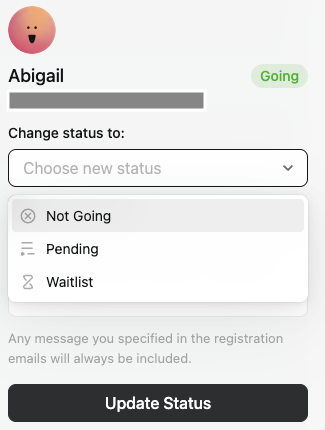
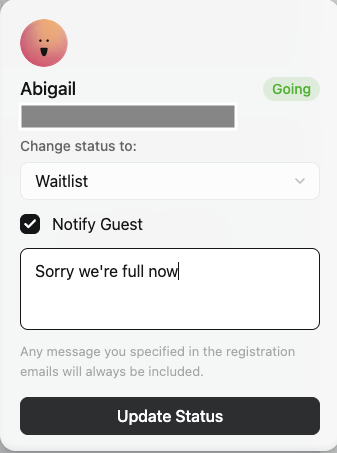
2. You can add event collaborators
You can invite additional co-host to your event so that your team members can also help manage the RSVPs and send emails. You can even grant them different level of permission to your event.
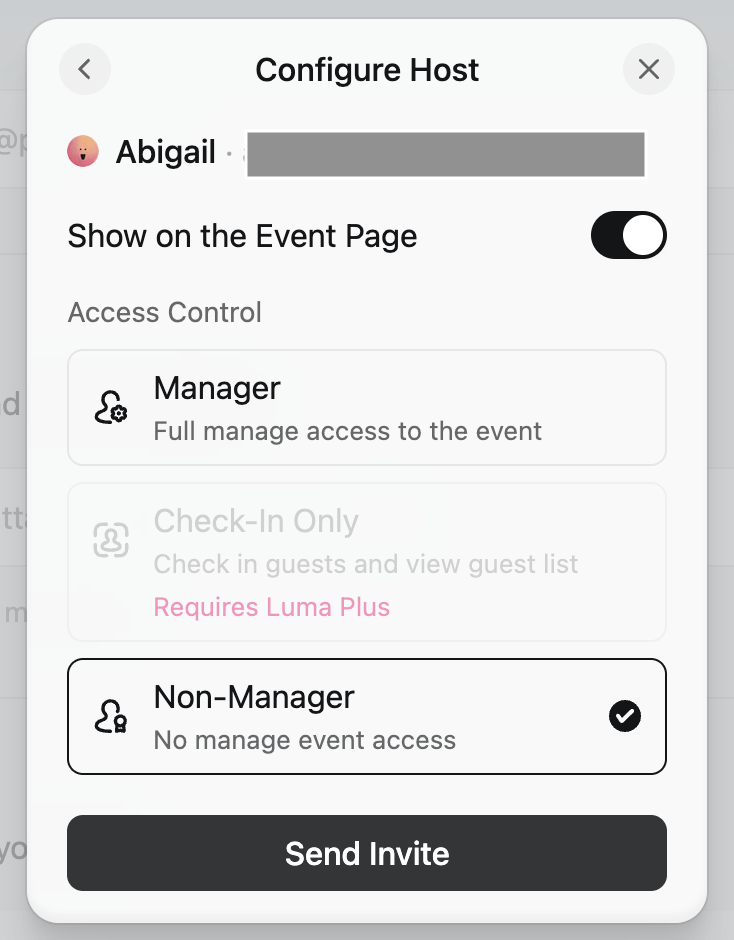
3. You can send invitations to the event
It has an interface that lets you invite people to your event, by typing in individual email addresses, or by uploading a CSV file. Instead of you having to write your own email message, with a few clicks of a button, it lets you send a personalized email along with the event details and the RSVP link.
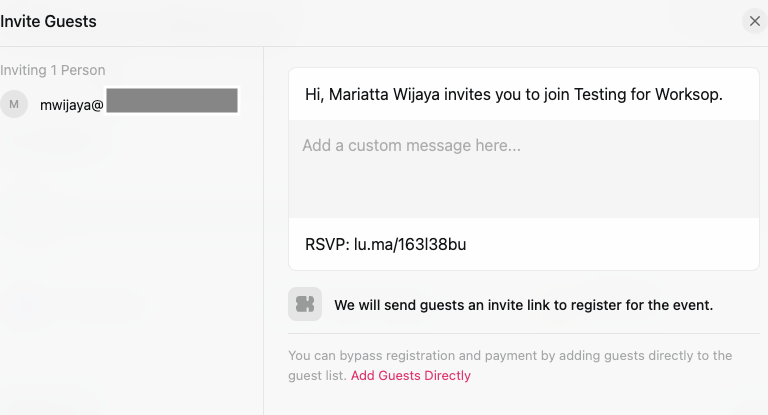
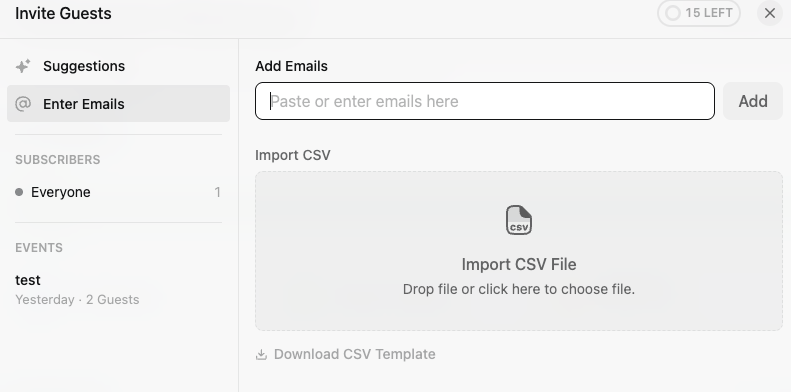
4. You can create custom questions
Not only you can add custom questions to the RSVP, Luma comes with built-in question types that aren’t just “plain text” fields. For example, you can add a “phone-number” question, and it could validate the phone number format for you.
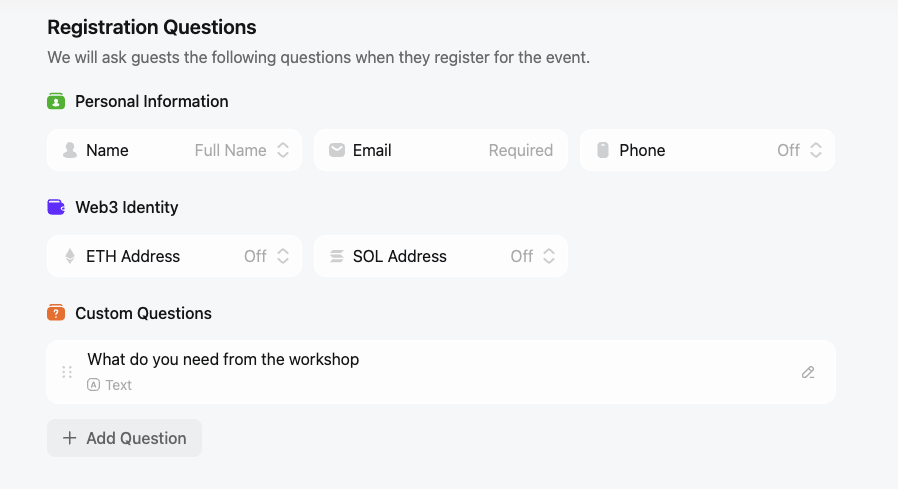
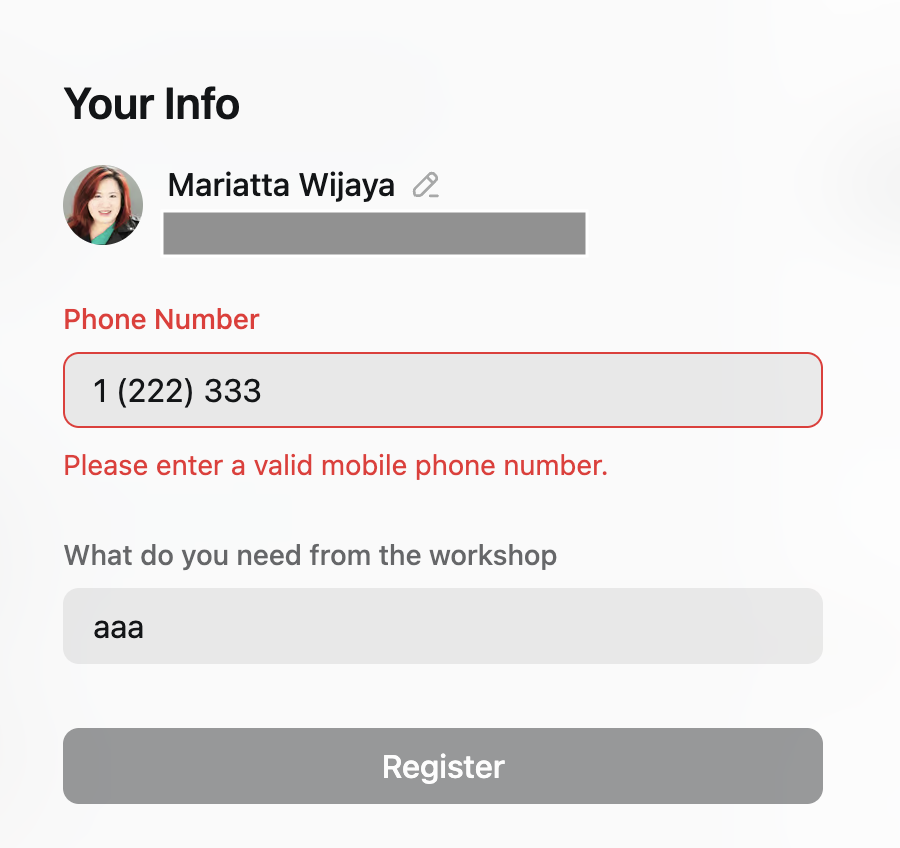
It even has a “Terms” question type that lets you add a link to your terms and conditions, and requires the attendees to sign it before they can RSVP. Think about requiring your attendees to agree to your code of conduct, or if your venue has their own NDA form. This is feature is very helpful for community organizers.
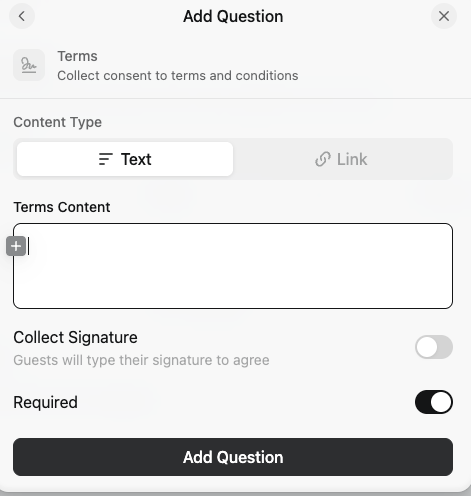
5. It’s easy to communicate with your attendees
Luma has a built-in email blast feature, that lets you send emails to your attendees, or to a specific group of attendees.
Not only that, it also has built-in event reminders and post-event feedback features that you can enable with just a few clicks.
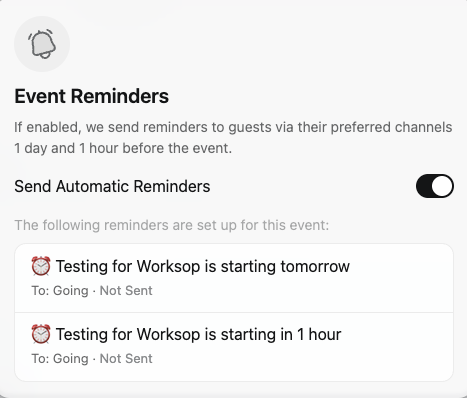
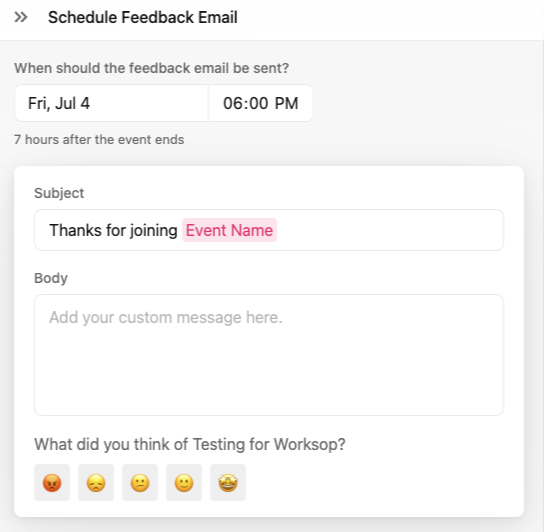
6. Emeddable to your website
Through Luma, you can create embed code that you can paste into your website. I don’t see many other event management tools do this, and definitely not spreadsheets.
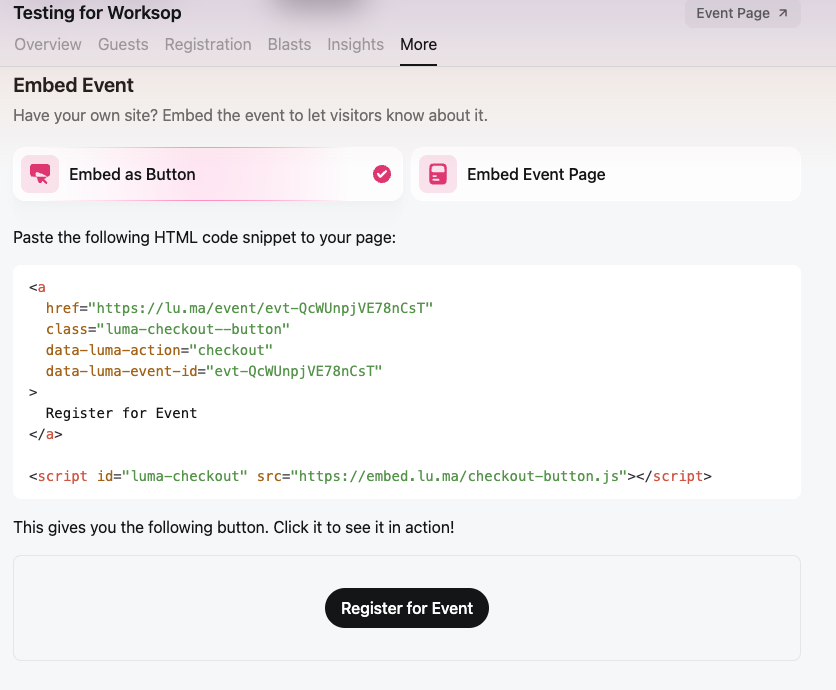
7. Analytics
Luma has built-in analytics that gives you insight about your event and your audience. Your spreadsheet doesn’t have this. Not even Meetup has this.
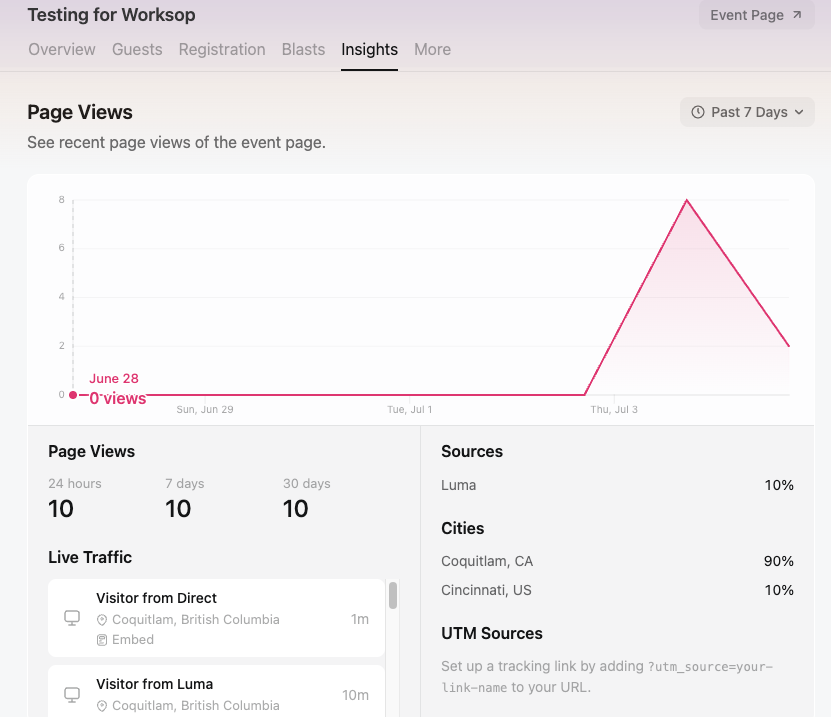
8. It’s free
The above features I mentioned are all free. There are some paid features like API integration and custom domain.
From what I’ve seen, the free version is more than enough for most community organizers. API integration is probably gonna be useful if you’re running a conference or something like that. But if you’re running a small meetup, a once in a while event, a small workshop, then the free version is more than enough. Definitely better than spreadsheets.
Conclusion
Just stop using spreadsheets for your event RSVPs.
I have a similar complaint about using spreadsheets for your conference CFPs, but that’s a topic for another day.
I also want to note that I’m unaffiliated with Luma. I don’t work for them, I don’t have friends who work for them. Luma never asked me to write this post. I don’t think anyone from Luma even knows me.
The inspiration for this blog post came after a brief conversation during PyLadiesCon planning meeting. At PyLadiesCon, we think twice before using spreadsheets for anything. (You may want to watch my other talk about “No More Spreadsheets”)
Anyway, Abigail Dogbe is planning to run a workshop for PyLadiesCon, and one of the things she needed is to collect RSVPs for her workshop, and she asked if she should use a form for that.
We all hesitated because for all the reasons I mentioned above. You see, all of the PyLadiesCon organizers are all experienced community organizers, we all know the pitfalls of using spreadsheets and forms as RSVP platform. And therefore, we needed to come up with a different way to do things.
I then chatted with Abigail, told her about Luma, gave her a demo, walked her through the features. It only took 15 minutes for her to be convinced that Luma is the right tool for her event.
If you haven’t heard of Luma before this, now you know. Go check it out, and stop using spreadsheets for event RSVPs.
I'm Open to work
I'm an independent software consultant with 20+ years of tech industry experience with expertise in Python and Django. I'm open to work and available for speaking engagements. Let's chat!
Follow and Subscribe
comments powered by Disqus
